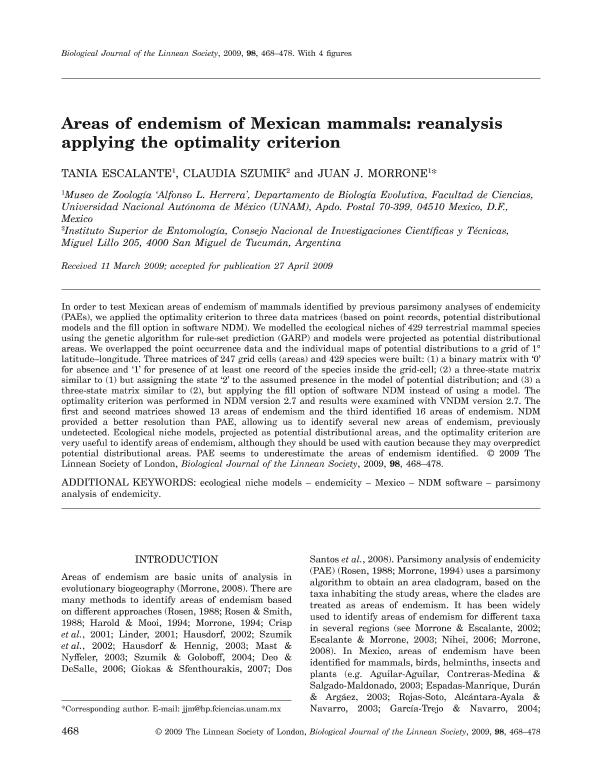Mostrar el registro sencillo del ítem
dc.contributor.author
Escalante, Tania

dc.contributor.author
Szumik, Claudia Adriana

dc.contributor.author
Morrone, Juan José

dc.date.available
2019-07-12T19:00:09Z
dc.date.issued
2009-04
dc.identifier.citation
Escalante, Tania; Szumik, Claudia Adriana; Morrone, Juan José; Areas of endemism of Mexican mammals: Re-analysis applying the optimality criterion; Wiley Blackwell Publishing, Inc; Biological Journal of The Linnean Society; 98; 2; 4-2009; 468-478
dc.identifier.issn
0024-4066
dc.identifier.uri
http://hdl.handle.net/11336/79505
dc.description.abstract
In order to test Mexican areas of endemism of mammals identified by previous parsimony analyses of endemicity (PAEs), we applied the optimality criterion to three data matrices (based on point records, potential distributional models and the fill option in software NDM). We modelled the ecological niches of 429 terrestrial mammal species using the genetic algorithm for rule-set prediction (GARP) and models were projected as potential distributional areas. We overlapped the point occurrence data and the individual maps of potential distributions to a grid of 1° latitude–longitude. Three matrices of 247 grid cells (areas) and 429 species were built: (1) a binary matrix with ‘0’ for absence and ‘1’ for presence of at least one record of the species inside the grid-cell; (2) a three-state matrix similar to (1) but assigning the state ‘2’ to the assumed presence in the model of potential distribution; and (3) a three-state matrix similar to (2), but applying the fill option of software NDM instead of using a model. The optimality criterion was performed in NDM version 2.7 and results were examined with VNDM version 2.7. The first and second matrices showed 13 areas of endemism and the third identified 16 areas of endemism. NDM provided a better resolution than PAE, allowing us to identify several new areas of endemism, previously undetected. Ecological niche models, projected as potential distributional areas, and the optimality criterion are very useful to identify areas of endemism, although they should be used with caution because they may overpredict potential distributional areas. PAE seems to underestimate the areas of endemism identified.
dc.format
application/pdf
dc.language.iso
eng
dc.publisher
Wiley Blackwell Publishing, Inc

dc.rights
info:eu-repo/semantics/openAccess
dc.rights.uri
https://creativecommons.org/licenses/by-nc-sa/2.5/ar/
dc.subject
Ecological Niche Models
dc.subject
Endemicity
dc.subject
Ndm Software
dc.subject
Pae
dc.subject.classification
Zoología, Ornitología, Entomología, Etología

dc.subject.classification
Ciencias Biológicas

dc.subject.classification
CIENCIAS NATURALES Y EXACTAS

dc.title
Areas of endemism of Mexican mammals: Re-analysis applying the optimality criterion
dc.type
info:eu-repo/semantics/article
dc.type
info:ar-repo/semantics/artículo
dc.type
info:eu-repo/semantics/publishedVersion
dc.date.updated
2019-07-10T14:24:59Z
dc.journal.volume
98
dc.journal.number
2
dc.journal.pagination
468-478
dc.journal.pais
Reino Unido

dc.journal.ciudad
London
dc.description.fil
Fil: Escalante, Tania. Universidad Nacional Autónoma de México; México
dc.description.fil
Fil: Szumik, Claudia Adriana. Universidad Nacional de Tucumán. Facultad de Ciencias Naturales e Instituto Miguel Lillo. Instituto Superior de Entomología; Argentina. Consejo Nacional de Investigaciones Científicas y Técnicas. Centro Científico Tecnológico - Tucumán. Unidad Ejecutora Lillo; Argentina
dc.description.fil
Fil: Morrone, Juan José. Universidad Nacional Autónoma de México; México
dc.journal.title
Biological Journal of The Linnean Society

dc.relation.alternativeid
info:eu-repo/semantics/altIdentifier/doi/https://doi.org/10.1111/j.1095-8312.2009.01293.x
dc.relation.alternativeid
info:eu-repo/semantics/altIdentifier/url/https://academic.oup.com/biolinnean/issue/98/2
Archivos asociados
